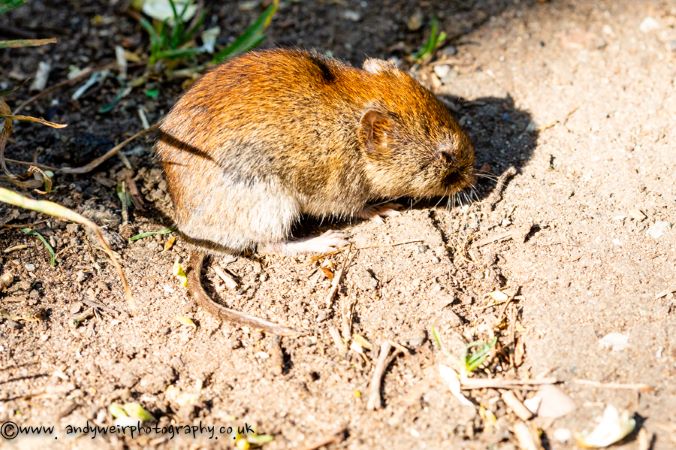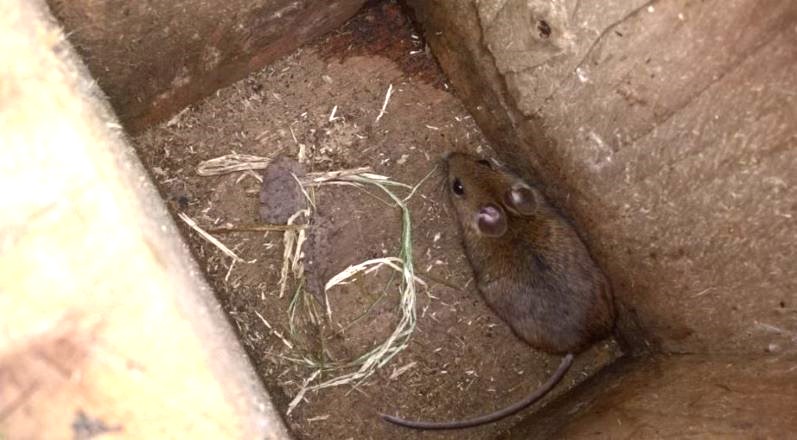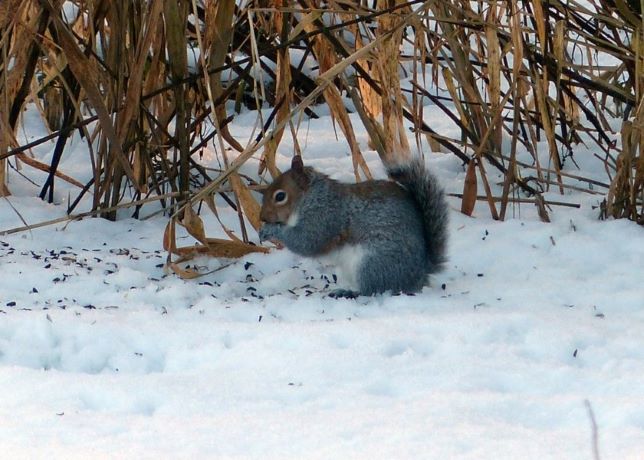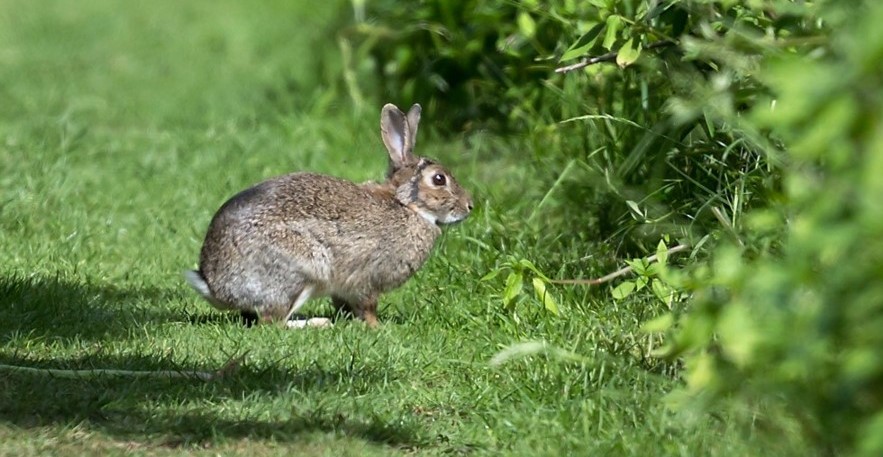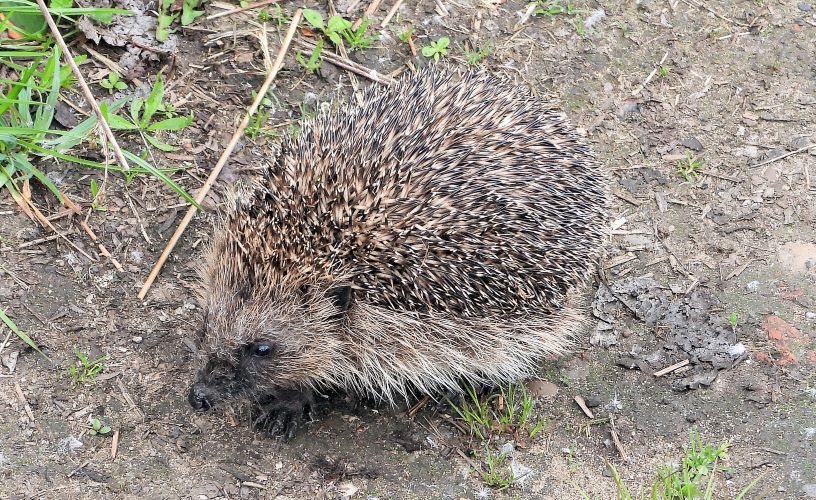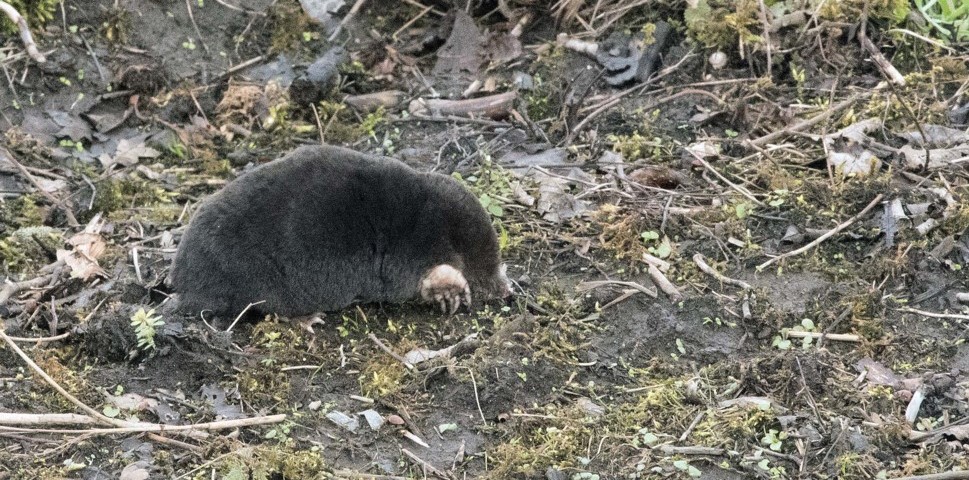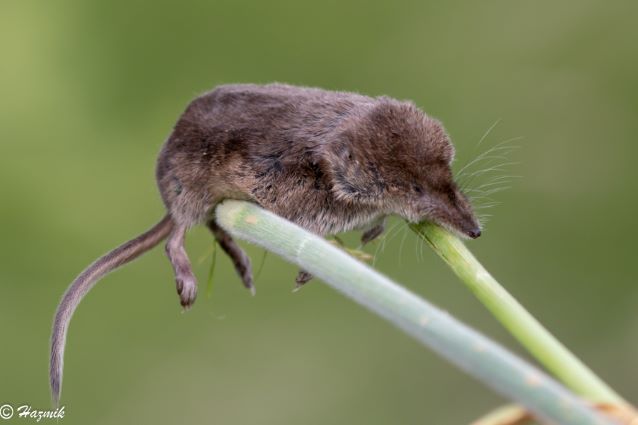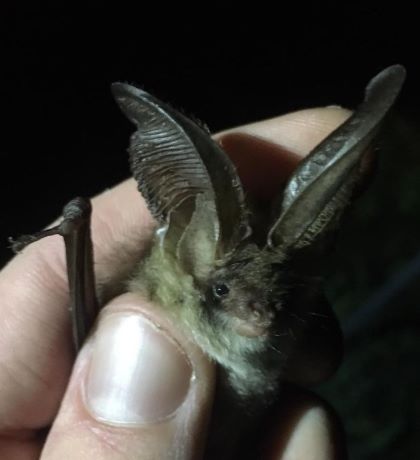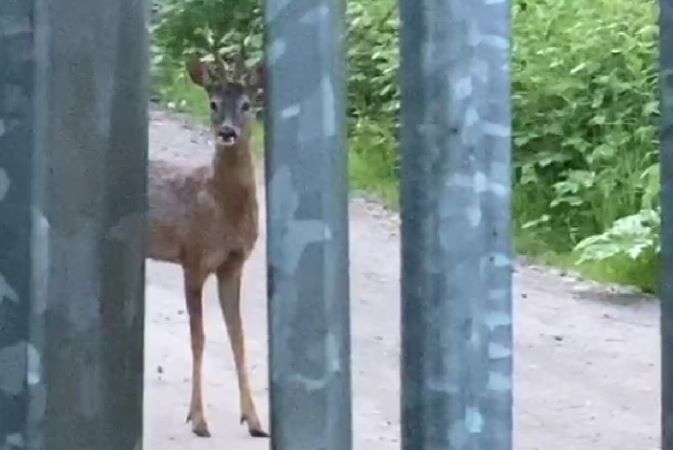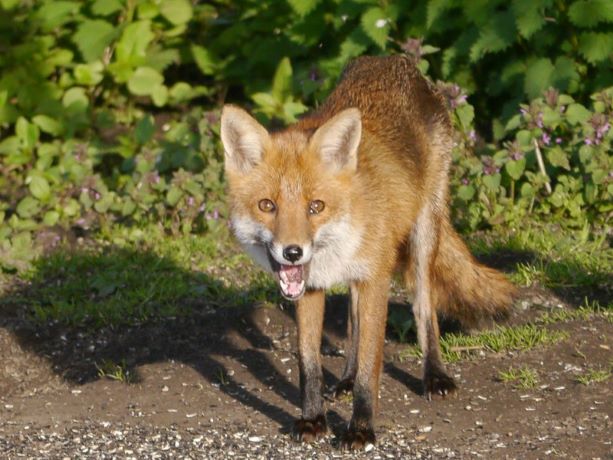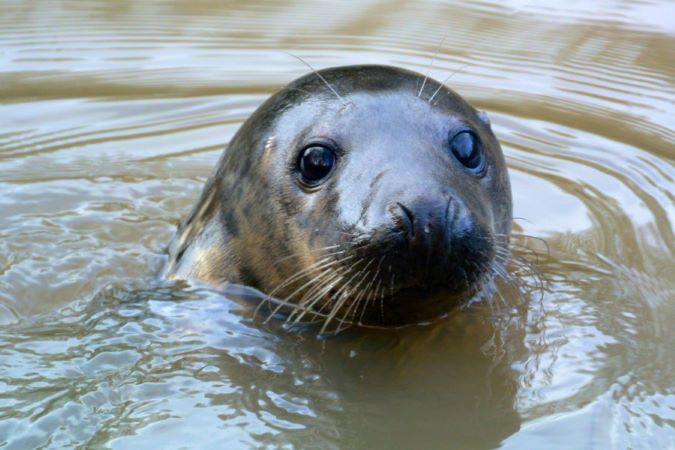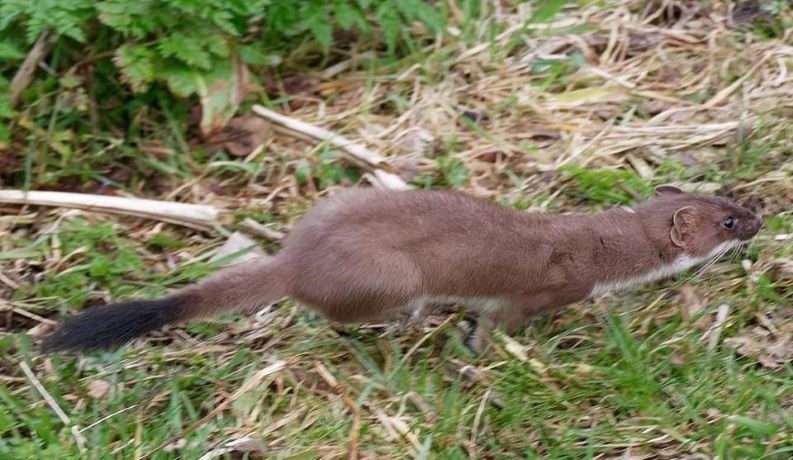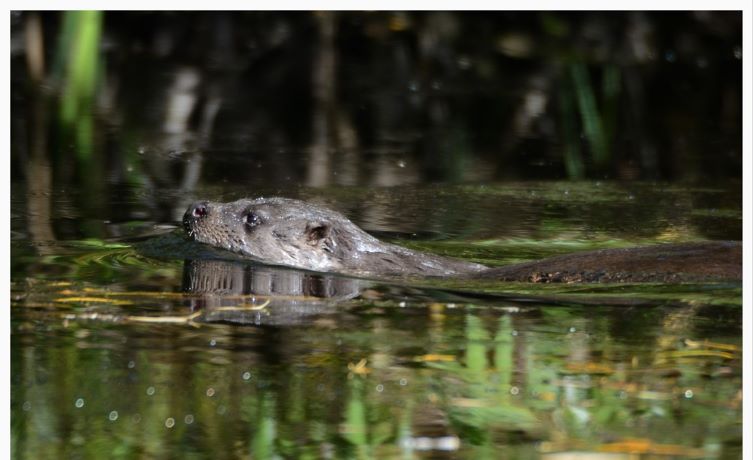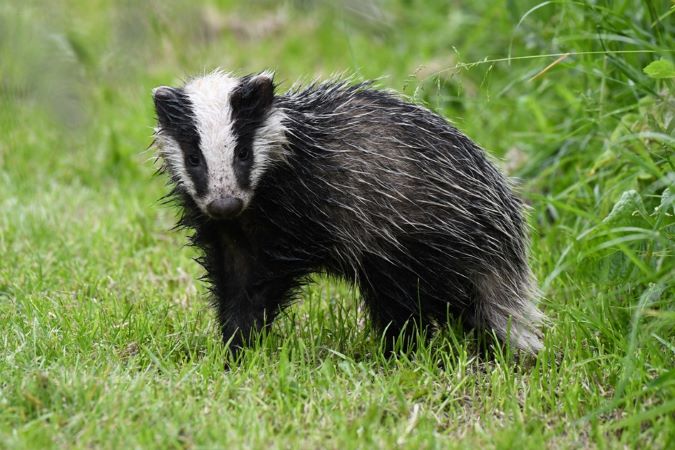Mammals Species Recorded at Woolston Eyes
There are 24 species of mammal native to the UK which have been recorded on the Reserve and two introduced species belonging to the following orders:
- Rodentia - rats, mice, squirrels etc. - 7 species
- Lagomorpha - rabbits, hares etc. - 2 species
- Eulipotyphla - the insectivores - eaters, hedgehogs, moles, shrews, etc. 4 species
- Artiodactyla - the herbivorses- boars, deer - 1 species
- Chiroptera - bats 5 species Download the Bat survey undertaken in 2007
- Pinniped - the aquatic fin-footed mammals - Seals - 1 species
- Carnivora - the dog-like carnivores, foxes, weasels, stoats, badgers etc. 6 species
Woolston Eyes Recorded List of Mammels
Summary identification, status notes and Reserve photographs of the mammals recorded follow:
Andy Weir from No3 bed 5th June 2018
01 Bank Vole (Clethrionomys glareolus)
Identification The species is around 83 to 121mm body length with a tail of 38 to 76mm, half as long as the body. Their weight is around 15 to 36g. It differs from the similar species Short-tailed or Field Vole by larger ears, longer tail and reddish-brown fur.
Status First recorded in the 1982 study of the prey of Short-eared Owl by examination of their pellets. Occasionally encountered on the Reserve.
02 Field Vole (Microtus agrestris)
Identification Mouse like but with a blunter nose the Field Vole is 90 to 115mm long and its weight is 20-40g. It is similar to the Bank Vole but distinguished by yellow-brown to greyish fur, shorter tail, roughly 1/3rd of its body length, the ears are usually not visible hidden by the shaggier fur. Active during day and at night.
Status This small vole also known as, Short-tailed Vole, was first officially noted as present in 1979 and breeding has been confirmed during the 1980 Warrington New Town Ecological Survey of 1980.
03 Water Vole (Arvicola terrestris)
Identification This species is the largest of the voles in the UK and dwarfs its smaller cousins being 140 to 220mm long, a tail of 95 to 140mm and a weight of 150-300g. Known also as the Water Rat, although similar looking at first glance they are distinguished from rats by the rounder noses, short stubby ears, chubby not sleek appearance and fleshy parts covered with hair - ears, tail and paws, has chestnut brown fur and small eyes and ears.
Status
John Blundell Wood Mouse found in a Blue Tit nest box 18th April 2018 on No.1 Bed
04 Wood Mouse (Apodemus sylvaticus)
Identification Wood Mouse have large ears (compared to the common house mouse) and long tails, roughly the same as the body length. This mouse is 80 to 100mm long with a tail of 70 to 95mm and a weight around 25g. It is more golden-brown over the back rather then greyish.
Status Common but is mostly nocturnal and not often encountered. The best chance of seeing Wood Mouse (also known as Field Mouse or Long-tailed Field Mouse) is around the hides on No3 Bed and particularly the feeding stations foraging for spilt seed.
05 Brown Rat (Rodentia norvegicus)
Identification A large rodent 150 to 270mm in body and 100 to 240mm tail length and a weight of 200 to 300g. Has grey-brown fur, a long pointed nose, large bare ears and a long scaly tail.
Status Rats can be found in any habitat, all they really need is shelter and food. The best chance of seeing Brown Rat is foraging under the bird feeders on No3 Bed.
06 Dormouse (Muscardinus avellanarius)
Identification Dormice are small rodents, have gingery-brown fur, a long furry tail and large black eyes. They have a body length of 60 to 90mm, a tail of 60 to 70mm and a weight of 15 to 40g.
Status Dormice are highly nocturnal and the only record of this rodent is referenced in the 1980 Warrington New Town Ecological Survey by K Dunne, R Barber and H Fisher.
Dave Bowman No.3 bed 26th January 2013
07 Grey Squirrel (Sciurus carolinensis)
Identification Probably requires no introduction but for continuity, they are 240 to 290mm long, have a tail length of 195 to 240mm and a weight of 400 to 650g. Despite their name they can have a surprising amount of reddish colour around the head, feet and back but are mostly silvery-grey over the rest of the body.
Status Grey Squirrels numbers have increased dramatically on the Reserve and surrounds in recent years and sightings are now common. Their breeding and winter drays are evident across the Reserve in the standing trees and they frequently take advantage of the bird seed at the various feeding stations.
08 Brown Hare (Lepus europarus)
Identification One of the largest members of the lagomorpha, the body length of 480 to 750mm and weight of 2.5 to 7kg bears testament to that status. Unmistakable long hind legs and ears with characteristic black patches viewed from the back.
Status Records date back to early years when grassland was much more extensive across the Eyes. There have been no records for many years.
Hazel Rothwell No.3 bed 31st May 2017
09 Rabbit (Oryctolagus cuniculus)
Identification Grey-brown fur, long ears, long hind legs and a small bobble tail around 400mm in length and 1 to 2 kg in weight. Moves with a slow motion hop until it senses danger when it dashes and twists for cover.
Status Rabbits are extremely common on the reserve particularly on the sandier banks and dense bramble cover along the Ship Canal track and boundaries of the four beds. An early morning arrival is best.
David Riley No.1 bed 06/05/2022
10 Hedgehog (Erinaceus europaeus)
Identification Our only member of the ‘spiny’ mammal family and are unlike any other UK mammal thus being recognised by all. Generally nocturnal in habit, their main predator is the badger.
Status Few reports of hedgehog sightings are submitted but they are present throughout the reserve.
Chris Monks No.3 bed 16/03/2016
11 Mole (Talpa europaea)
Identification Black velvety fur covering the whole body which highlights the large pale flesh of the front digging feet. Length 150mm with a tail of 50mm and a weight of 75 to 135g.
Status Live specimens are only occasionally seen but, generally subterranean the ‘molehills’ (spoil from their tunnels) are the first sign of their presence which are evident on the reserve.
Hazel Rothwell No.3 bed 22/06/2016
12 Common Shrew (Sorex araneus)
Identification This is a small rodent at 50 to 80mm in length with a 20 to 40mm tail and a weight of 5 to 14g. It has a notable pointed snout and small black eyes and is identified by the species tri-colouration, dark-brownish above changing to a richer chestnut-brown on the flanks and greyish-silver underneath. It is larger than the Pygmy Shrew and has a tail around half it’s body length, the Pygmy has a tail around two thirds of it’s body length.
Status Although active day and night it is difficult to spot and is often only seen crossing a pathway or deceased on a pathway. It is one of the most common Shrew on the Reserve and an important food prey for the carnivorous mammals, Kestrel and Owls.
13 Pygmy Shrew (Sorex minutus)
Identification At 50mm (2 inches) this is 2/3rds the size of the Common Shrew. It is common but seldom seen, although active during the day and night. It is distinguished from the similar Common Shrew by its bi-colour coat, brownish grey on top and whitish beneath. Common Shrew exhibits tri-colouration, dark on top shading to brownish grey then white underneath and longer looking tail at 2/3rds body length.
Status Is common on the Reserve.
14 Daubenton's Bat (Myotis daubentoniid)
Identification Bats are naturally very difficult to observe and identification is generally obtained from studies of the echolocation frequencies individual species use. Daubenton’s Bat call frequencies range from 32 to 85kHz but typical calls peak at 45 to 50kHz. Daubenton’s is a medium to small bat being 45 to 55mm with a wing span of 240mm to 275mm and a weight between 7g and 15g.
Status This species is associated with water, preferring woodland habitat, bridges, buildings etc. adjacent to water.
15 Common Noctule Bat (Nyctalus noctule)
Identification Common Noctules have two common calls the frequencies of the first range from 26 to 47kHz, most energy being at 27kHz and last for 11.5ms. The second call frequency is 22 to 33kHz, having most energy at 22kHz and having most energy at 22kHz and a typical duration of 13.8ms. The Common Noctule is a large bat being typically 80mm with a wing span of 350mm.
Status This species prefers wooded areas and typically flies above and around the canopy.
16 Common Pipistrelle Bat (Pipistrellus pipistrellus)
Identification The Common Pipestrelle is the smallest bat in Europe being 45 to 55mm with a wing span of 180mm to 250mm and a weight between 3.5g and 8.5g. Common Pipistrelle Bat call frequencies range from 45 to 76kHz, have most energy at 47kHz and last for 5.6ms.
Status It is very common on and around the Reserve and can be encountered feeding on small insects at dusk and dawn along tree lines and clearings.
17 Soprano Pipistrelle Bat (Pipistrellus pygmaeus)
Identification The Soprano Pipestrelle was only separated from the Common Pipistrelle Bat in 1999 which it closely resembles in all aspects (see Common Pipistrelle above) other than echolocation frequencies. Soprano Pipistrelle call frequencies range from 53 to 86kHz, have most energy at 55kHz and last for 5.8ms.
Status It was determined to be quite common on the Reserve in the 2007 survey we undertook but arm yourself with a bat detector to identify it.
Daniel Gornall No.3 bed 19/09/2020
18 Brown Long-eared Bat (Plecotus auritus)
Identification A medium sized bat, 40-50mm in body and 230-285mm wingspan, with upper light brown fur and pale underneath. Has the longest ears of the UK bats at 28mm. Frequents open deciduous and conifer woodland, parkland etc. Common throughout the UK. Calls are very quiet, echo location frequency of 25-50kHz with a peak of 35kHz, but are often heard just as a series of clicks.
Status The bat in the photograph was caught unintentionally in a bird ringing net and was the first identified bat of this species on the Reserve, Others will be present.
Mike Lloyd No.2 bed 20/05/2020
19 Roe Deer (Capreolus capreolus)
Identification Our most widespread native deer who do not form herds but live generally as solitary individuals or small family groups. A relatively small deer standing around 100cm at the shoulder and is generally reddish brown in colour, more so in the summer months, and a white tail patch. Only the male carries antlers which are short, even in older bucks are only around 200mm long and generally only developing two or three points.
Status Roe Deer were considered accidental visitors to the Reserve and not resident. Although infrequently seen their tracks are very common place.
David Spencer No,3 bed 04/05/2016
20 Fox (Vulpa vulpa)
Identification Standing around 400mm at the shoulder and weighing 5 to 8 kg the russet red fur above, white cheeks and lower muzzle and erect pointed ears makes the Fox unmistakeable.
Status Largely nocturnal but can be sighted anywhere on the Reserve especially at dawn and dusk and during the spring when feeding young necessitates longer foraging often in daylight and cubs venture from the underground den.
David Bowman No.3 bed 05/01/2016
21 Grey Seal (Halichoerus grypus)
Identification This is the larger of the two UK seals weighing in at 200 to 300kg and a length up to 2.5 m. Mainly grey in colour the best characteristic, check the nostrils from a frontal view; Grey Seals have nostrils which stay relatively parallel and wider apart as they drop towards the mouth and Common Seals have the nostrils in a ‘V’ shape, wide at the top and narrowing towards the mouth.
Status In recent times Grey Seals have become visitors to the River Mersey and Woolston Eyes edges following improvement in the water quality. One spent some time in the River Mersey adjacent to the northern edges of No.4 and No.3 Beds in the spring of 2000. Another seal was located on nearby Howley Weir in 2012. It is thought these seals follow the first salmon runs into the river from Liverpool Bay.
David Bowman No.3 bed 04/03/2021
22 Stoat (Mustela erminea)
Identification Very similar to the Weasel but larger, a body length of 240 to 320mm, tail of 90 to 140mm and a weight to 150g and is the one with a black tip to the tail. Ermine is the name given to Stoat in the characteristic white winter coat.
Status Present on the Reserve but infrequently observed.
23 Weasel (Mustela nivalis)
Identification The Weasel is smaller than the related Stoat 170 to 220mm in length with a 30 to 50mm tail and a weight of 60 to 130g and is the one without the black tip to the tail. It is the smallest British carnivore with a long tan body with white underparts and short legs.
Status This secretive mammal is present but infrequently recorded on the Reserve.
Brian Gort No.3 bed 03/09/2014
24 Otter (Lutra lutra)
Identification The largest of the UK mustelids at a 600 to 800mm body length, a 300mm to 600mm tail and a weight of 6 to 8 kg. The sheer size should indicate an Otter from our other mustelids but the short snout which gives it a flat-faced look is also a distinguishing feature. Otters have grey-brown fur with pale chests, throat and neck.
Status The first record of Otter was of one seen and photographed on the old river under the footbridge to No.3 Bed on 3rd September 2014. Other records followed of sightings in the adjacent River Mersey and inside No3 bed on the main shallow flooded lagoon.
Jean Hood No.3 bed 14/06/2019
25 Badger (Meles meles)
Identification Large, stocky with a body length of 750 to 1000mm, a short hairy tail and a weight of 8 to 12kg. Badgers are our largest predator and unmistakeable with grey back and sides, black legs and belly and a very distinctive black and white striped face.
Status Badgers are nocturnal. Sightings on the Reserve are infrequent but the evidence of their existence is widespread with the evidence along the pathways in particular were their ‘grubbings’ for earthworms and larvae in the short grass can be seen daily. They are most frequently seen on No.3 Bed, walking along or crossing the paths and foraging under the feeders around the John Morgan Hide.
26 American Mink (Mustela vison)
Order: Carnivora Family: Mustelidae
Identification Variable in colour but the majority of the Mink seen on site have been uniformly dark brown/black. They are on average 550mm in length with a tail close to 300mm long and a weight of 4 to 5 kg and in classic coat a small white chin extending down to the throat. They are smaller than otter, the only other mustelid likely to be confused with and have a smaller more pointy snout.
Status They are now widespread in the UK and Woolston has maintained a population for a number of years. Equally at home in the water as on land they are serious predators and pose a threat to our breeding birds, especially young and juvenile wildfowl. Sightings on the Reserve are regular but infrequent.

